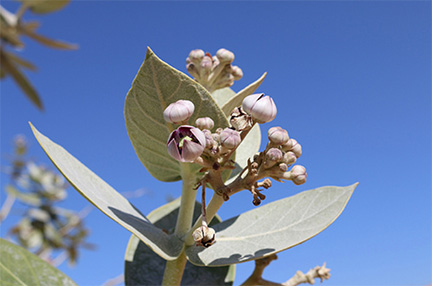
On Flickr there is a nice photo montage of plants and animals in the United Arab Emirates. check it out here. This was put up by Thorsten Gerald Schneiders, who has several photostreams about the UAE.

On Flickr there is a nice photo montage of plants and animals in the United Arab Emirates. check it out here. This was put up by Thorsten Gerald Schneiders, who has several photostreams about the UAE.
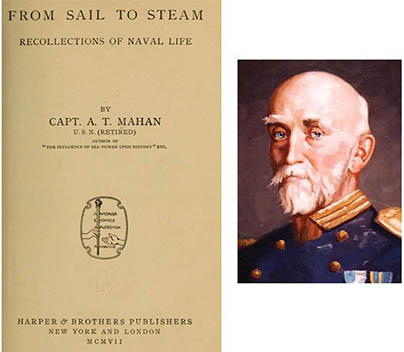
Alfred Thayer Mahan (1840-1914)
The American admiral Alfred Thayer Mahan is often noted as the man who coined the phrase “Middle East.” After he served in the U.S. Navy on the Union side, he sailed to Hong Kong and passed by the port of Aden in 1867. His comments are brief and reflective more of his own biases than anything significant about Aden. He does provide an interesting description of camels. His narrative is available on archive.org, but I attach here the relevant pages on Aden.
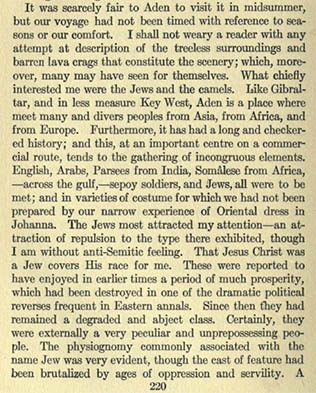
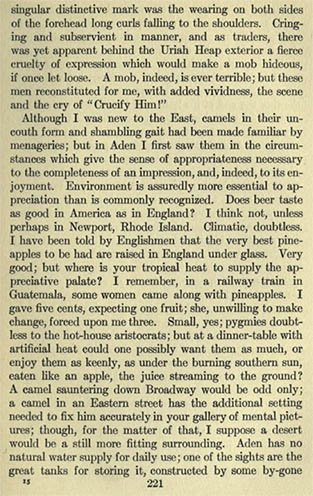
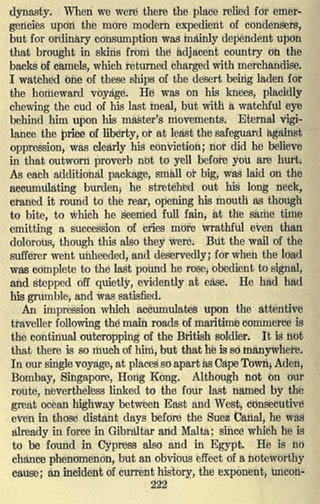

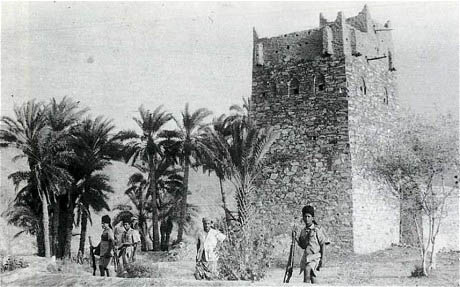
A husn or stronghold in Wadi Bayhan
The Telegraph, March 12, 2014
Nigel Groom, who has died aged 89, was an Arabist, historian, author, soldier, spy-catcher and perfume connoisseur. These pursuits saw him fend off a tribal assassination attempt in Aden, uncover a KGB spy embedded in the RAF and explain the association between frankincense and Christ’s divinity.
As a young Political Officer for the Colonial Service, Groom arrived in the British Protectorate of Aden in 1948. He was responsible for the north-eastern area, based in Bayhan, a remote emirate bordering the central Arabian Desert, and accessible only by small RAF aircraft. Two years later he took over the northern area, based in Al Dhali’, regarded at the time as a difficult, ungoverned tribal part of the Protectorate, riven by unrest fuelled by the Imam of Yemen in pursuance of his claims over the whole country.
At Christmas in 1950 the British agent for the western area of the Protectorate, Basil Seager, and his wife arrived to spend the holiday in Al Dhali’, unaware that a plot was afoot to assassinate both Seager and Groom (and their escort of Arab soldiers) at a Christmas Day lunch in a nearby village. However, while out for a walk with armed guards on Christmas Eve, Seager and his wife by chance met the chief assassin, a religious fanatic high on khat, and his party on their way to their assignment. The assassin stabbed Seager with his dagger, causing serious injury, and in the subsequent gunfight several of the escort and several assailants were killed. Groom signalled to Aden for a doctor, who arrived after a five-hour night-time journey over rough tracks, and for a substantial force of Aden Protectorate Levies, to leave early on Christmas morning to help counter a planned tribal uprising. Continue reading Nigel Groom
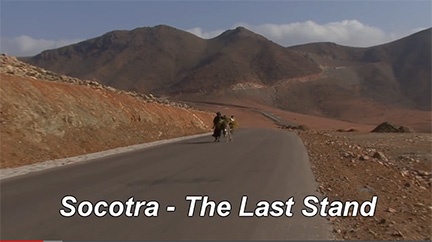
One of the remaining marvels off the east coast of Africa is the island archipelago of Socotra, historically associated with Yemen, the nation which it belongs to. Socotra is a preserve of biodiversity with a local population not yet catapulted into the under-development pains of the 21st century. There is a fascinating film about the need to protect Socotra’s unique environment and its people from the devastating impact of uncontrolled “development.” Among the individuals speaking is Dutch ecologist Paul Scholte, who has extensive research experience both in Yemen and Africa. Check out both parts of the film here and here. There are a number of Youtube videos on Socotra, but most are tourist oriented and do not match the information level of this film.
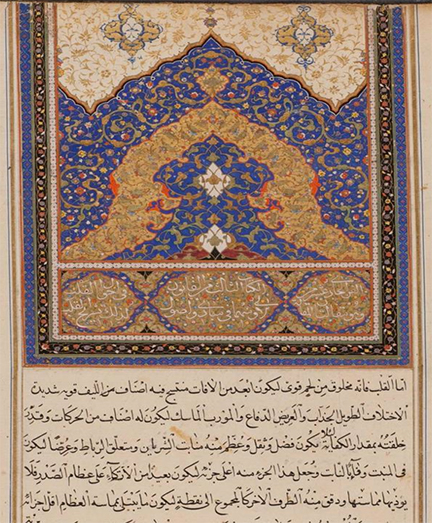
Ibn Sina’s (d. 1037 CE) Qanun, copied in Shiraz in 1645 CE
For anyone interested in the history of Islamic medicine, there are some rare editions of texts by famous Muslim scholars like Ibn Sina (Avicenna), Ibn Masawayh, al-Antaki, al-Damiri, and others, including a few 19th century French translations published in North Africa. These are available to view or as pdfs at Yale University’s library. Below is the press release about the collection:
YALE UNIVERSITY PRESS RELEASE
This digitized collection of selected volumes of medical books and manuscripts, dating from 1300 to 1921, is drawn from the Medical Historical Library, Cushing/Whitney Medical Library. This collection reflects the Arabic and Persian intellectual efforts that translated, augmented, and transmitted Greek and Roman medical knowledge to Western societies during the Renaissance. It includes iconic works by authors such as Avicenna and al-Razi.
The Medical Historical Library, originally formed by the joining of three collections by bibliophiles Harvey Cushing, John Fulton, and Arnold Klebs, has over 120,000 volumes dating from the 12th to the 21st centuries. While primarily composed of works in Western medicine and science, a smaller selection of Arabic and Persian books and manuscripts are a “hidden collection” in the Library. Through the support of the Arcadia Fund, the Medical Historical Library was able to digitize Arabic and Persian books and manuscripts, as well as early translations in Latin, French, and English. Continue reading Islamic Medicine at Yale
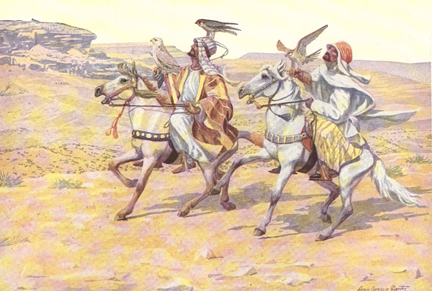
“The Start: Arabs Setting out with Falcons to Course Gazelles. It is difficult to tell just when hawking began. The Arabs, perhaps as early as any other people, trained certain hawks to course the swift desert game. In coursing gazelles, three, five or more hawks are used, and the aid of dogs is required for the actual kill, the hawks worrying and bewildering the game until the dogs can catch up. These hawks are always fed from the eye-sockets of a calf’s head, and naturally turn to this spot in their living quarry. There is great danger that the hawks may be impaled on the horns of the gazelle.
In leafing through a vintage National Geographic Magazine from December, 1920, I came across an article entitled “Falconry, the Sport of Kings” by Louis Agassiz Fuertes, who also drew the paintings included with his text. Falconry, as Fuertes writes, was far more than the sport of kings: “A vast impetus was given to falconry by the returning crusaders, who had become familiar with the methods of the Orient and had brought with them both falcons and trainers. War lords never left their courts without their falconers and a cadge of hawks, to be flown at anything that might be deemed worthy.” The author noted that hunting with falcons was greatly curtailed after the introduction of guns, but continued as a sport. But he wrote just after the Great War, now known as World War I, had ended, and hoped that some of the “less serious pursuits” like falconry would be revived. Although his article does not discuss the falconry of the Middle East in any detail, it does provide two illustrations, which I provide above and below.
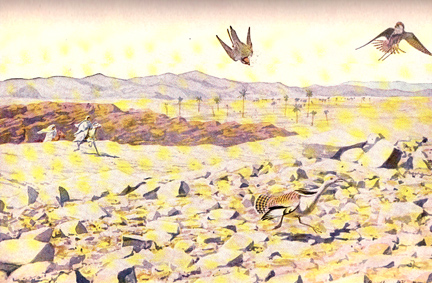
This is one of the most thrilling of all uses of the falcon, for the chase often continues for many miles over the rough desert, where only the stanchest horse can follow. The size and stamina of the quarry, combined with the habit of fleet running instead of flying, make it hard as well as dangerous for the little lanner falcon to kill, as there is so little space to turn away from the ground after the stroke.

The photographs here were taken of camels and people in Libya around 1957 by Dr. Virgil Clift.


[Tabsir Redux is a reposting of earlier posts on the blog, since memories are fickle and some things deserve a second viewing. This post was originally made on April 27, 2013]

The latest issue of CyberOrient is available online.
Articles
Online and Offline Continuities, Community and Agency on the Internet
Jon W. Anderson
http://www.cyberorient.net/article.do?articleId=8355
The Earth Is Your Mosque (and Everyone Else’s Too): Online Muslim
Environmentalism and Interfaith Collaboration in UK and Singapore
Lisa Siobhan Irving
http://www.cyberorient.net/article.do?articleId=8336
Telling the Truth about Islam? Apostasy Narratives and Representations
of Islam on WikiIslam.net
Daniel Enstedt and Göran Larsson
http://www.cyberorient.net/article.do?articleId=8459
Comments
Digital Images and Visions of Jihad: Virtual Orientalism and the
Distorted Lens of Technology
Raymond Pun
http://www.cyberorient.net/article.do?articleId=8391
Reviews
Review: Arabités numériques. Le printemps du Web arabe
LuboÅ¡ KropáÄek
http://www.cyberorient.net/article.do?articleId=8352
Review: Media, Power, and Politics in the Digital Age. The 2009
Presidential Election Uprising in Iran
Zuzana Krihova
http://www.cyberorient.net/article.do?articleId=8386
Review: iMuslims: Rewiring the House of Islam. Islamic Civilization
and Muslim Networks
Vit Sisler
http://www.cyberorient.net/article.do?articleId=8385